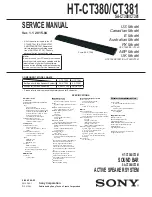
HT-CT380/CT381
4
SECTION 1
SERVICING NOTES
UNLEADED SOLDER
Boards requiring use of unleaded solder are printed with the lead-
free mark (LF) indicating the solder contains no lead.
(
Caution:
Some printed circuit boards may not come printed with
the lead free mark due to their particular size)
: LEAD FREE MARK
Unleaded solder has the following characteristics.
• Unleaded solder melts at a temperature about 40 °C higher
than ordinary solder.
Ordinary soldering irons can be used but the iron tip has to be
applied to the solder joint for a slightly longer time.
Soldering irons using a temperature regulator should be set to
about 350 °C.
Caution:
The printed pattern (copper foil) may peel away if
the heated tip is applied for too long, so be careful!
• Strong
viscosity
Unleaded solder is more viscous (sticky, less prone to
fl
ow)
than ordinary solder so use caution not to let solder bridges
occur such as on IC pins, etc.
• Usable with ordinary solder
It is best to use only unleaded solder but unleaded solder may
also be added to ordinary solder.
NOTE OF PERFORMING THE OPERATION CHECK IN
THE STATE THAT HEAT SINK WAS REMOVED
When performing the operation check in the state that this unit was
disassembled, it is possible to perform the operation check in the
state that heat sink was removed. But don’t perform the operation
check in the long time, and perform the operation check in the
volume state as low as possible.
CAPACITOR ELECTRICAL DISCHARGE PROCESSING
When checking the board, for the electric shock prevention, con-
nect the resistors to both ends of respective capacitors to discharge
the capacitor.
Note 1:
When the connector that connects the POWER board to the MAIN
board is disconnected before discharging, completely
fi
nish dis-
charging both boards, and then reconnect the connector. If dis-
charging is not complete, sparking may occur when connecting the
connector and cause a blown fuse.
Note 2:
Be sure to discharge using a resistor of 800
Ω
or higher.
(Do not discharge with a 0
Ω
resistor)
Discharging at a location where excessive electric current
fl
ows
through a fuse may cause the fuse to blow.
– MAIN Board (Side A) –
C3015
C3016
800
:
/2 W
800
:
/2 W
– POWER Board (Conductor Side) –
C967
800
:
/2 W
800
:
/2 W
C914 (US and Canadian models)
C915 (Except US and Canadian models)
The SERVICING NOTES contains important information for servicing. Be sure to read this section before repairing the unit.
MODEL IDENTIFICATION
Distinguish by Part No., destination code and color on the bottom side of the main unit.
– Bottom view –
MODEL LABEL
Part No.
Destination code
Model
Part No.
Destination code
SA-CT380: US,CND
4-559-882-0
[]
UC2
SA-CT380: AEP
4-559-883-0
[]
CEL/B
SA-CT380: EA3
4-564-730-0
[]
EA3
SA-CT381: AEP
4-564-737-0
[]
CEL/S
SA-CT381: UK
4-565-719-0
[]
CEK/S
SA-CT380: UK
4-565-720-0
[]
CEK/B
SA-CT380: PX
4-565-721-0
[]
PX3
SA-CT380: SP
4-565-722-0
[]
SP1
SA-CT380: E3
4-565-729-0
[]
E3
SA-CT380: AUS
4-565-730-0
[]
AU1
Ver. 1.1





































